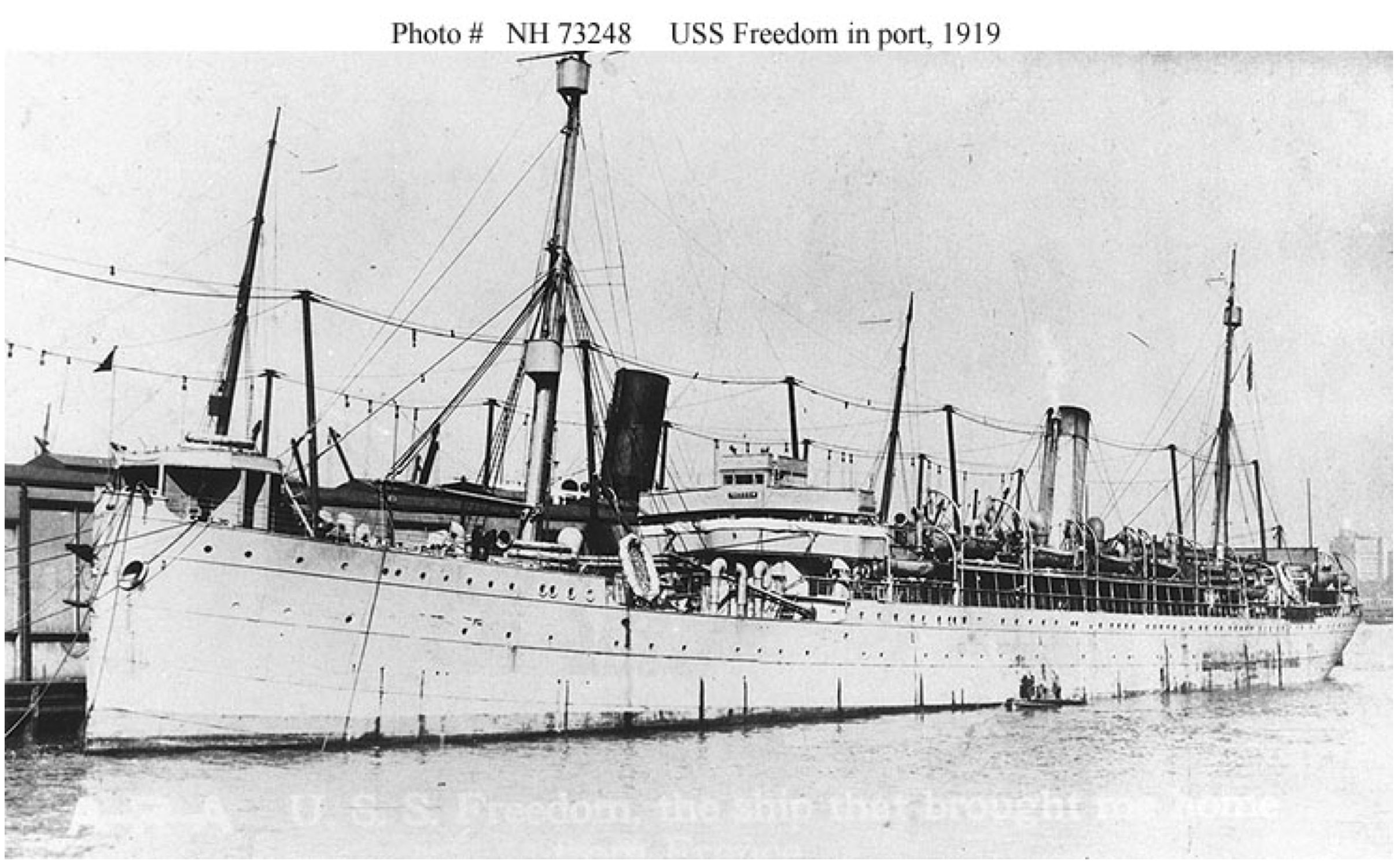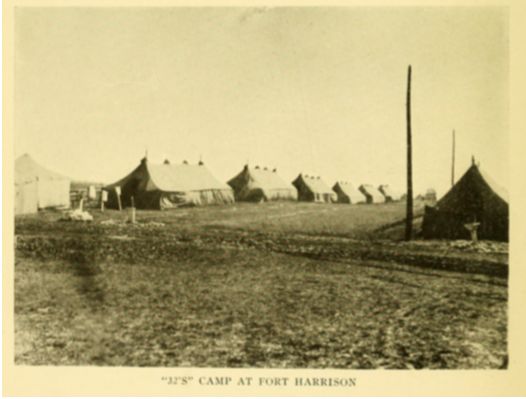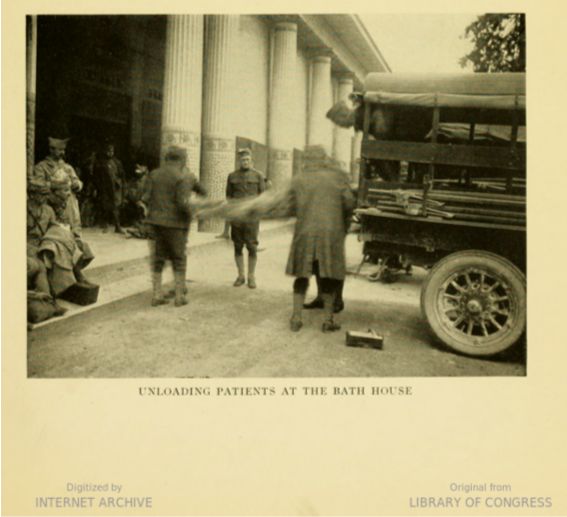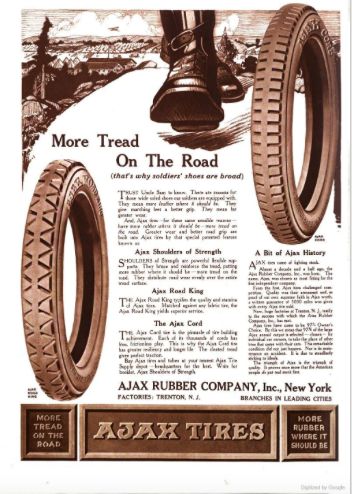
| 9 Jan 1896 - 7 Feb 1942 |
 Glenn grabbed the railing and held his head over the edge of the ship as his lunch came rolling out and hit the water below. Sour liquid squirted up into his nose. His eyes were watering. Along the sides of the ship other soldiers were also spewing up vomit. The U.S.S. Freedom was a long and narrow boat. As a result, even in the calmest of seas it rocked from side to side causing the seasickness that the men were experiencing. The ship was also taking a long time to make the crossing and not only was the canteen out of supplies but the food in the mess hall was really going down hill. Glenn continued to dry heave for several minutes after his stomach was empty. Despite his condition he couldn’t help but be pleased. After seventeen months in France he was headed back to the States. Although the war ended six months ago it had taken two months for Base Hospital 32, where Glenn had served as a medic, to close its doors. Besides a two week general duty stint at Grenoble after the war ended, Glenn had helped tear down and pack up the hospital in Contrexeville. When the hospital finally closed its doors in January its personnel traveled to the point of embarkation at Naviere. Officers and female personnel long gone ahead, it took the military seven weeks to get the enlisted men on a ship and headed for home. The U.S.S. Freedom was a small German freighter that had been seized by the United States in 1917. It was so slow that another ship, the U.S.S. Leviathan, had passed them on their second day out as the other ship headed toward France. Then the Leviathan passed them again on their twelfth day out as it was heading back to America. Although the men had called out to it to throw them a line and tow them along, the ship moved on leaving them behind and was out of site over the horizon in a very short time. Once Glenn’s stomach quit reversing itself, for a reprieve his thoughts reviewed the last two years of his life and all that he had experienced. Glenn Smith was born in Peru, Indiana on January 9. 1896. He was the son of John W. Smith and Una Sarah Fansler Smith. Both of Glenn’s parents were also born in Indiana. His dad worked as a conductor on the railroad. Glenn was still living with his parents and siblings in Peru in 1900, but by the time he registered for the draft in June of 1917 he was living in Indianapolis and working for Ajax Rubber Company selling tires. Examination of enlisted men had begun the prior month for service in Base Hospital 32, and papers were signed by the end of June. They were to be ready to go whenever called. The origin of Base Hospital 32 was a large donation on behalf of the Eli Lilly Company early in 1917 to begin the formation of a hospital unit from Indianapolis in case the country should enter the war. Donations from citizens of Indianapolis along with a large donation from the personal funds of J.K. Lilly made the formation of a hospital a reality. The men were mustered into service to staff it at the beginning of September in 1917.  Of medium height and build, with brown hair and brown eyes, Glenn Smith’s name is listed among those who were trained at Fort Harrison as part of Base Hospital 32. Upon arrival to Fort Harrison, in addition to uniforms and clothing each man received a mess kit, a shelter half, three blankets and a luxury known as a bed sack. A bed sack was filled with straw and served as a mattress. While at Fort Harrison, time was spent not only training in military drill and formation, army regulation and articles of war, but also in physiology and practical first aid work. Besides roll call, exercises, drill periods and lectures, they had to do guard duty, policing duty and kitchen work. In three months, at the beginning of December, they left Indianapolis for Hoboken, New Jersey, and on December 4, 1917 set sail for France aboard the U.S.S. Washington. This ship had been been the largest German built steamship and the third largest ship in the world when it was launched in 1908. When WWI started, the then neutral United States had interned the ship. In 1917 the U.S. seized the ship and took it over for troop transport. Base Hospital 32 was included in its first load of troops. On December 20, 1917 they arrived in Brest France but remained on the ship until Christmas Eve at which time they left Brest by train. They celebrated Christmas aboard the train during a snowstorm as they traveled toward their destination, Contrexeville, France. Contrexeville is located 230 miles east and a little south of Paris. It is 18 miles south of Naufchateau. Surrounded by the foothills of the Vosges Mountains, Contrexeville is in a sheltered basin and is known for its medicinal and therapeutic springs. The springs caused Contrexeville to be a summer vacation spot for the more wealthy French. Because of this it had modern conveniences such as concrete sidewalks, parks, a sewage system and electricity which other small French towns did not. Contrexeville was also on a railway line. All these things made it an ideal location for a military hospital. Several large hotel buildings were to be converted into hospitals and offices. But the arrival of equipment was delayed, and the buildings had to be cleaned and prepared for use as a hospital. The equipment had been shipped to France ahead of the group but still had to be trucked over land to Contrexeville after their arrival. Besides cleaning and scrubbing everything there was also upgrading work to be done to plumbing and electrical systems in order to enable them to handle hospital needs and be up to proper standards. Finally the Base Hospital was ready to open with 1000 beds the end of February. Because a river ran underneath the city, staff were able to establish a bath house. Patients were bathed upon arrival to Contrexeville. Clothing was taken and sterilized. The patients left the bath house in clean pajamas, bundled in robes and blankets and they were sent to the correct hospital building according to their type of injury and the specific care they would need. Very serious cases would be sent directly to the wards from the train. From May to October 30, 1913 baths were given at the bathhouse. The summer of 1918 was very busy. At one point they were caring for 1450 patients. Between early spring and the first of September 3695 patients had been treated at Base Hospital 32: 2682 of them American, 884 French, 117 British and even 12 enemy prisoners. 2810 soldiers had returned to duty and eleven patients had died. The rest had been transferred to other facilities or were still recovering on site. Over two thousand patients were admitted each month in September and October. During WWI, base hospitals functioned mostly as evacuation hospitals. They received the patients from field hospitals, operated on them and sent them as quickly as possible on to hospitals farther back from battle for convalescence. In July of 1918, Glenn wrote a letter home to his mother in Peru, Indiana. He had just gotten up after sleeping during the day. He had spent the night before unloading wounded soldiers from the train to be treated at Base Hospital 32.  Base Hospital 32 was supported by the presence of both the American Red Cross and the YMCA. On August 27 and 28, 1918 Glenn Smith won a big tennis competition while serving in Contrexeville. It was a five set match with the final deciding set win going to Glenn with a score of 8 to 6. He was a Private. Back home family members of the Base Hospital 32 employees formed an auxiliary to gather and send gifts and items that the hospital crew might need. Glenn’s mother, Mrs. J.W. Smith, is listed as a member of the auxiliary association. On January 7, 1919 the hospital officially closed after caring for 9698 patients of which only 118 died. On February 20 personal started for home but the men did not board the U.S.S. Freedom until April 13. They docked in New York on April 28. On the seventh of May they arrived home in Indianapolis and by May tenth everyone was honorably discharged. At that point Base Hospital 32 ceased to exist. It is not known what Glenn did for the first several years after the war ended, but in 1927 he moved from Indianapolis to Los Angeles, California. After that he graduated from Manual Training High School which is a Los Angeles Public High School. It originally opened as a vocational school in 1910. Glenn worked for Lockheed Corporation in Los Angeles which was an aircraft manufacturing company. On December 24, 1937 Glenn married Dora Elizabeth Gansmann who was born in Mexico. He was 41 and she was 34. Then on February 7, 1942 Glenn Smith passed away after a two month illness. He is buried in Los Angeles. He left behind his wife Dora, a daughter Marilyn, a sister Mildred, and two brothers Lynn and Ernest. Glenn Smith was born in Miami County, Indiana. He served our country during WWI by providing medical care to wounded soldiers in France. His service is appreciated and remembered by the people of Miami County, Indiana. Researched, written & submitted by Mary Rohrer Dexter |
| “Army and Navy Register.” 6 July 1918. Ajax Rubber Company advertisement. "California, County Marriages, 1850-1952," database with images, FamilySearch (https://familysearch.org/ark:/61903/1:1:K8VS-B9F : 8 December 2017), Glenn Smith and Dora Elizabeth Gansmann, 24 Dec 1937; citing Los Angeles, California, United States, county courthouses, California; FHL microfilm 2,114,157. Find A Grave, Una Sarah Fansler Smith Find A Grave, John W Smith. Find A Grave, Karl D Smith Find A Grave, Lloyd V Smith. Find A Grave, Glenn Smith. “Glenn Smith.” Indianapolis Star, 9 Feb. 1942, p. 14. “Glenn Smith Military Record.” NARA, St Louis, MO. Incomplete military record located for a Glenn Smith. Pay check stubs etc. HITZ, BENJAMIN D. HISTORY OF BASE HOSPITAL 32: Including Unit r (Classic Reprint). American Legion, Indianapolis, 1922. "Indiana Marriages, 1811-2007," database with images, FamilySearch (https://familysearch.org/ark:/61903/1:1:QV99-V4JF : 10 December 2017), Thomas H Smith and Jane Trippier, 30 Apr 1854; citing Miami, Indiana, United States, various county clerk offices, Indiana; FHL microfilm 2,431,845. Indiana World War One Military Veterans “Letters From Sammies.” Unknown Miami County Paper, 1918. “Lockheed Corporation.” Wikipedia, Wikimedia Foundation, 12 Nov. 2018, en.wikipedia.org/wiki/Lockheed_Corporation#Prewar_production. “Manual Arts High School.” Wikipedia, Wikimedia Foundation, 12 Apr. 2018, en.wikipedia.org/wiki/Manual_Arts_High_School. “NavSource Online: Service Ship Photo Archive.” Submarine Photo Index, www.navsource.org/archives/09/22/22019.htm. “SS George Washington.” Wikipedia, Wikimedia Foundation, 29 Oct. 2018, en.wikipedia.org/wiki/SS_George_Washington. Swanson, Bob. The Great Lakes from Moby Dick, swansongrp.com/bob.html. "United States Census, 1880," database with images, FamilySearch (https://familysearch.org/ark:/61903/1:1:MH9T-24W : 14 August 2017), Thomas H Smith, Peru, Miami, Indiana, United States; citing enumeration district ED 120, sheet 541B, NARA microfilm publication T9 (Washington D.C.: National Archives and Records Administration, n.d.), roll 0298; FHL microfilm 1,254,298. "United States Census, 1900," database with images, FamilySearch (https://familysearch.org/ark:/61903/3:1:S3HT-DTT7-HYT?cc=1325221&wc=9BQP-MJ3%3A1030552501%2C1033690801%2C1034689001 : 5 August 2014), Indiana > Miami > ED 105 Peru Township Peru city Ward 3 > image 17 of 34; citing NARA microfilm publication T623 (Washington, D.C.: National Archives and Records Administration, n.d.). "United States World War I Draft Registration Cards, 1917-1918," database with images, FamilySearch (https://familysearch.org/ark:/61903/3:1:33S7-L148-YMX?cc=1968530&wc=9FC6-DP8%3A928312201%2C928720201 : 14 May 2014), Indiana > Indianapolis City no 3; G-U > image 4972 of 5828; citing NARA microfilm publication M1509 (Washington, D.C.: National Archives and Records Administration, n.d.). |
 |
 |
 |
